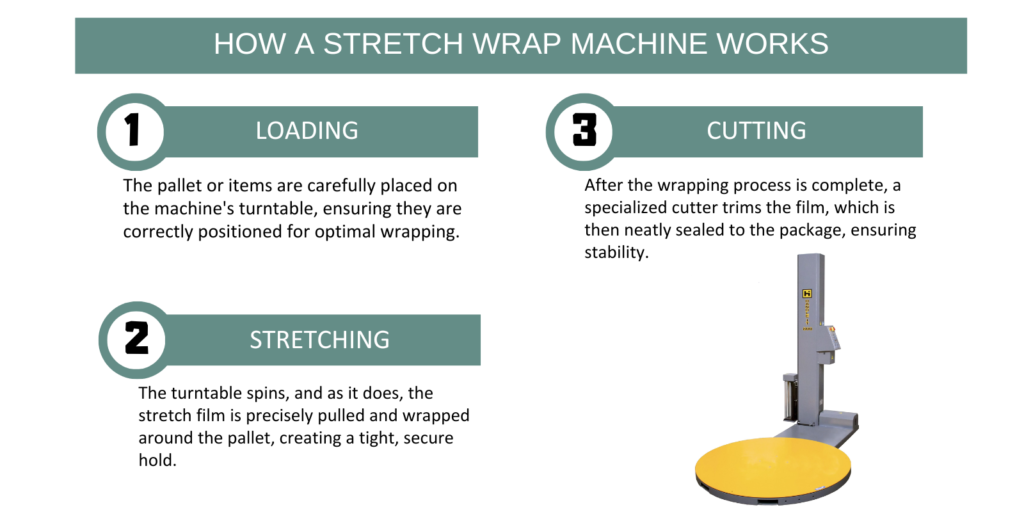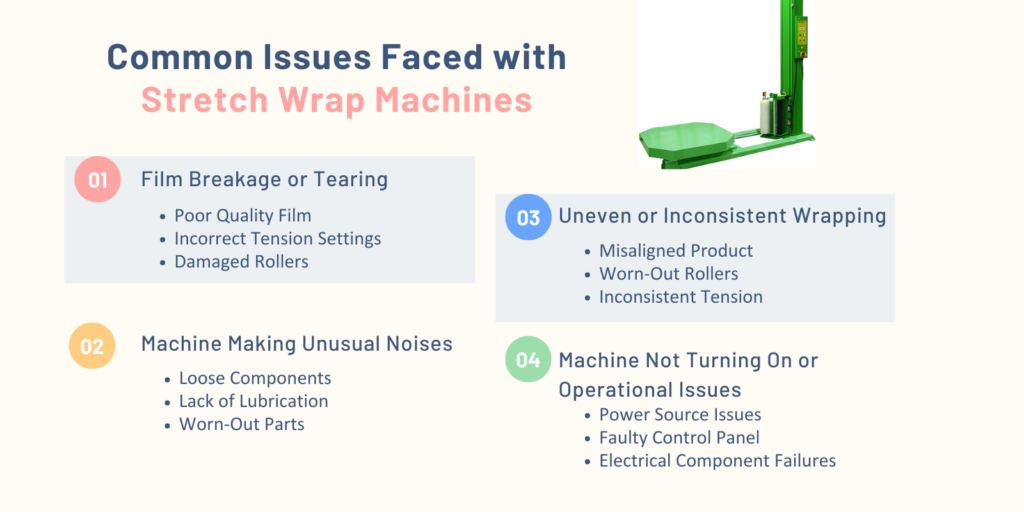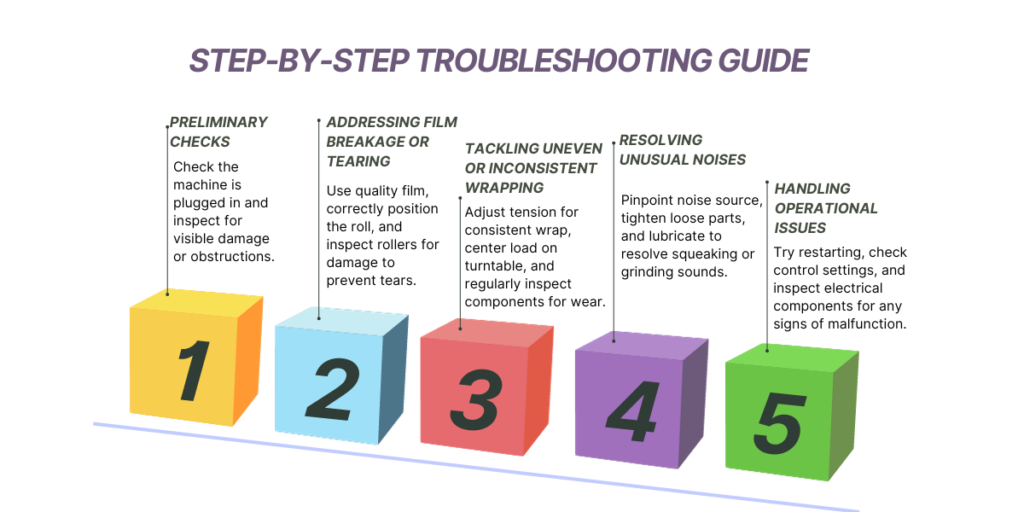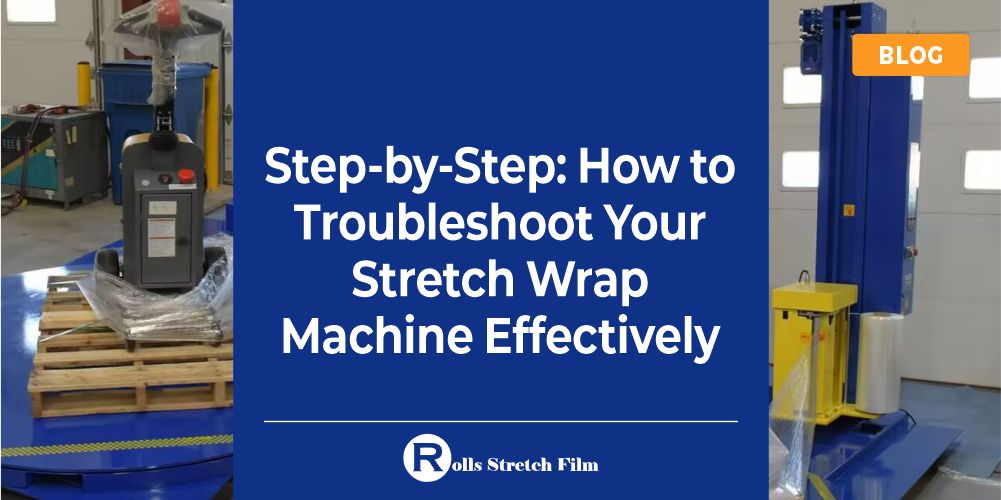Have you ever been in a packaging process when your stretch wrap machine suddenly malfunctions? How frustrating is it when production halves because of a seemingly minor issue? These machines are pivotal in ensuring products are packaged securely and efficiently. When they break down, it disrupts the workflow, leading to delays and potential financial setbacks.
Efficient troubleshooting of your stretch wrap machine is the key to minimizing downtime and maintaining productivity. By understanding common issues and their solutions, you can quickly address problems and get your operations back on track. This article provides a step-by-step guide to effectively troubleshoot your machine, ensuring you know how to tackle any hiccup. Stay with us, and you’ll gain valuable insights that will save you time, money, and stress in the long run.
Understanding the Basics of a Stretch Wrap Machine

When diving into the world of packaging and wrapping, it’s essential to grasp the fundamentals of the tools we use. One such indispensable tool is the stretch wrap machine. Let’s break down its basics to ensure we’re all on the same page.
How a Stretch Wrap Machine Works
At its core, a stretch wrap machine is designed to wrap stretch film around a loaded pallet or individual items, ensuring they’re secured for storage or transport. Here’s a simple breakdown of the process:
- Loading: The pallet or items are carefully placed on the machine’s turntable, ensuring they are correctly positioned for optimal wrapping.
- Stretching: The turntable spins, and as it does, the stretch film is precisely pulled and wrapped around the pallet, creating a tight, secure hold.
- Cutting: After the wrapping process is complete, a specialized cutter trims the film, which is then neatly sealed to the package, ensuring stability.

Common Components and Their Functions
Understanding the machine’s components is crucial for effective troubleshooting. Here are some of the primary components and their roles:
- Turntable: This is where the pallet or item sits. It rotates to allow the film to wrap around the product.
- Film Carriage: This component holds the roll of stretch film. It moves up and down, ensuring the film covers the entire height of the pallet or item.
- Control Panel: This is the machine’s brain. It allows operators to adjust settings like rotation speed, film tension, and up-down speed of the film carriage.
- Film Rollers: These help in stretching the film as it’s applied. They ensure the film is taut and covers the product uniformly.
- Cutting Mechanism: This component cuts the film once wrapping is complete, ensuring a neat finish.

A stretch wrap machine is a blend of mechanical and electronic components working in harmony to ensure products are wrapped securely and efficiently. By understanding its basics, we’re better equipped to address any issues that might arise, ensuring our operations run smoothly and effectively.
Common Issues Faced with Stretch Wrap Machines
In my years of experience with stretch wrap machines, I’ve come to realize that while these machines are incredibly efficient, they’re not immune to issues. Just like any other machinery, they have their quirks and challenges. Let’s delve into some of users’ most common problems and shed light on their causes.
A. Film Breakage or Tearing
One of the most frequent issues I’ve encountered is film breakage or tearing during wrapping. This can be due to:
- Poor Quality Film: Not all stretch films are created equal. Using a low-quality film can lead to frequent breakages.
- Incorrect Tension Settings: If the film is stretched too tightly, it can tear. Conversely, too little tension can result in slack and ineffective wrapping.
- Damaged Rollers: Rollers with sharp edges or wear can damage the film as it passes through.
B. Uneven or Inconsistent Wrapping
Another challenge is uneven or inconsistent wrapping, which can compromise the security of the wrapped items. Common causes include:
- Misaligned Product: If the product isn’t centered on the turntable, it can lead to uneven wrapping.
- Worn-Out Rollers: Rollers that have seen better days might not distribute the film evenly.
- Inconsistent Tension: Fluctuating tension settings can result in patches of tight and loose wrapping right and loose wrapping patches.
C. Machine Making Unusual Noises
Hearing strange noises from your machine can be alarming. These sounds often indicate:
- Loose Components: A rattling or clanking sound might mean there’s a loose part inside.
- Lack of Lubrication: A squeaking noise can indicate that moving parts need lubrication.
- Worn-Out Parts: Grinding sounds can indicate parts that are worn out and rubbing against each other.
D. Machine Not Turning On or Operational Issues
It’s particularly concerning when the machine doesn’t power up or has operational hiccups. Potential reasons are:
- Power Source Issues: Always check the basics first. Ensure the machine is plugged in and the power source is functional.
- Faulty Control Panel: The control panel is the machine’s brain. If it’s malfunctioning, the machine might not operate correctly.
- Electrical Component Failures: Electrical failures, like a blown fuse or a faulty circuit, can prevent the machine from turning on.

Stretch wrap machines are robust and reliable, but they’re not without challenges. But with a keen understanding of these common issues, we can address them promptly, ensuring minimal disruption to our operations.
Step-by-Step Troubleshooting Guide
Troubleshooting machinery can seem daunting, especially if you’re not familiar with its intricacies. However, with a systematic approach, most issues can be identified and resolved efficiently. Drawing from my experience, I’ve put together a step-by-step guide to help you navigate through common problems with your stretch wrap machine.
1. Preliminary Checks
Before diving deep into specific issues, it’s always wise to start with the basics. These initial checks can often pinpoint simple problems that might be causing the malfunction.
- Power Connection: It might sound obvious, but I’ve seen many instances where the machine wasn’t plugged in or the power source had issues. Always ensure the machine is connected to a working power outlet.
- Visual Inspection: Take a moment to inspect the machine for any visible signs of damage, wear, or obstructions. Sometimes, a stray piece of debris or a dislodged component can be the culprit.
2. Addressing Film Breakage or Tearing
Film breakage or tearing can halt your operations, but with a keen eye, you can identify and rectify the root cause.
- Film Quality: Over the years, I’ve learned that not all films are made equal. Ensure you’re using a high-quality film suitable for your machine and the products you’re wrapping.
- Film Roll Positioning: A misaligned or improperly loaded film roll can lead to breakages. Ensure the roll is seated correctly and the film feeds smoothly into the machine.
- Component Inspection: Take a closer look at the rollers and other components the film interacts with. Check for sharp edges, wear, or damage that might be causing the film to tear.
3. Tackling Uneven or Inconsistent Wrapping
Uneven wrapping not only looks unprofessional but can also compromise the security of the wrapped items. Here’s how to address it:
- Tension Settings: One of the first things I always check is the tension settings. If the film is too tight or too loose, it can result in inconsistent wrapping. Adjust the settings to find the right balance.
- Load Positioning: The placement of the load on the turntable is crucial. Ensure it’s centered to achieve an even wrap throughout.
- Component Check: Over time, some components can wear out or malfunction, leading to uneven wrapping. Regularly inspect parts, especially rollers, to ensure they’re in optimal condition.
4. Resolving Unusual Noises
A stretch wrap machine should operate smoothly with minimal noise. If you’re hearing unusual sounds, it’s a sign something’s amiss.
- Identify the Noise Source: Before jumping to conclusions, take a moment to pinpoint where the noise is coming from. This will guide your next steps.
- Loose Components: In my experience, a common culprit for strange noises is loose parts. Tighten any components that seem out of place or shaky.
- Lubrication: Just like any machinery, moving parts need to be well-lubricated. If you hear squeaking or grinding, it might be time to lubricate the machine.
5. Handling Operational Issues
Sometimes, the machine might not operate as expected or might not turn on at all. Here’s how to tackle such challenges:
- Restart the Machine: It might sound cliché, but turning the machine off and on can resolve many minor glitches. Give it a try.
- Control Settings: The control panel is the heart of the machine’s operations. Ensure all settings are correctly set and haven’t been accidentally altered.
- Electrical Inspection: If the machine isn’t powering up, there might be an electrical issue. Check fuses, circuits, and other electrical components for any signs of malfunction.

In my years of working with stretch wrap machines, I’ve learned that most issues have straightforward solutions. With a systematic approach and a keen eye for detail, you can ensure your machine operates efficiently, minimizing downtime and maximizing productivity.
Preventative Maintenance: Key to Avoiding Major Issues
In my journey with stretch wrap machines, I’ve come to a fundamental realization: prevention is always better than cure. While troubleshooting is essential, taking proactive steps to maintain the machine can save you a lot of time, money, and stress in the long run. Let’s delve into the importance of preventative maintenance and how it can be the key to avoiding major issues.
The Importance of Regular Maintenance Checks
Just like a car needs regular check-ups to run smoothly, so does a stretch wrap machine. Regular maintenance checks:
- Spot Issues Early: Before they escalate into major problems, potentially saving significant repair costs.
- Extend Machine Lifespan: A well-maintained machine can serve you efficiently for many years.
- Ensure Consistent Performance: Regular checks ensure the machine operates at its optimal capacity, delivering consistent results.
Tips for Maintaining Your Stretch Wrap Machine in Top Condition
Over the years, I’ve gathered a set of best practices that have proven invaluable in keeping stretch wrap machines in pristine condition:
- Regular Cleaning: Dust, debris, and residues can accumulate over time, affecting the machine’s performance. Make it a habit to clean the machine regularly, paying attention to rollers, turntables, and other components.
- Prompt Replacement of Worn-Out Parts: Parts like rollers and belts can wear out with time. Regularly inspect these components and replace them promptly when signs of wear are evident. This not only ensures smooth operation but also prevents potential damage to other parts.
- Proper Training for Operators: A machine is only as good as the person operating it. Ensure that all operators are adequately trained, familiar with the machine’s functions, and aware of best practices. This reduces the chances of user-induced errors and mishaps.
Conclusion
Drawing from my years of hands-on experience with stretch wrap machines, I can’t stress enough the significance of effective troubleshooting. It’s the bedrock of ensuring smooth operations, especially when unexpected challenges arise. But beyond addressing issues as they come, there’s immense value in being proactive. Prioritizing regular maintenance not only minimizes potential problems but also extends the machine’s lifespan, ensuring it remains a reliable asset in your operations. Remember, the knowledge and skills shared here are rooted in real-world practice, aiming to provide you with accurate and reliable guidance. Embrace these insights, and you’ll be well-equipped to navigate the intricacies of stretch wrap machines with confidence.














